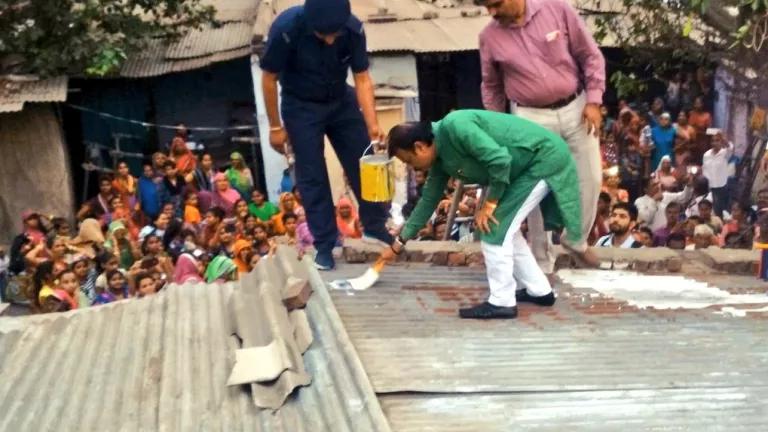
Ahmedabad mayor painting a cool roof in April 2018
With abnormally high temperatures spiking across India and increasing energy demand, cool roofs offer a major solution to urbanization challenges. Currently, less than 10% of India’s households have air conditioning units, while more than 60% of urban roofs are made from metal, asbestos, and concrete—trapping heat inside buildings. As living standards rise, demand for cooling and air conditioning will rise dramatically and can strain electric grids, worsen air pollution, increase fuel imports, and fuel climate change. Fortunately, key cities—Hyderabad and Ahmedabad—have pilot programs for cool roofs that are models for rapidly developing cities in India.
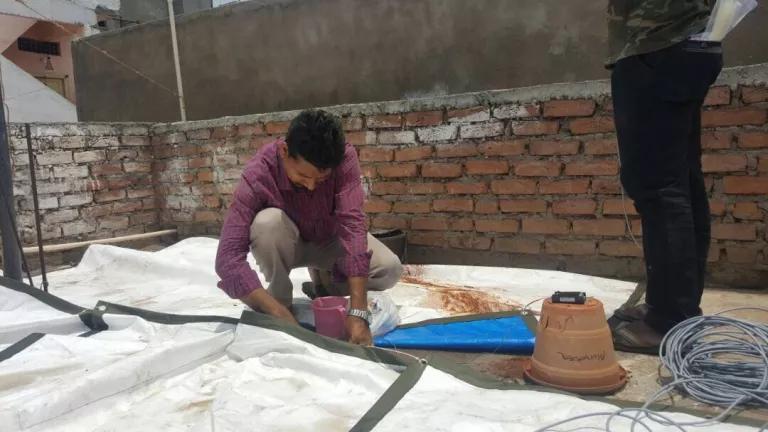
Cool roof installation in Hyderabad in 2017
Cool roofs offer a simple and cost-effective solution to urbanization challenges.
Cool roofs reflect sunlight and absorb less heat. Depending on the setting, cool roofs can help keep indoor temperatures lower by 2 to 5°C (3.6 - 9°F) as compared to traditional roofs. Cool roofs can cost as little as ₹0.5 per square foot for a simple lime-based paint, to more expensive reflective coatings or membranes.
Cities, states and the national government are taking concrete action to protect communities and save energy costs. For example, Ahmedabad has a cool roofs program for over 3,000 low income homes as part of its heat action plan. Hyderabad has a demonstration pilot aimed to design a broader program as part of its building energy efficiency program. The national government is working toward sustainable cooling with the National Cooling Action Plan and energy efficiency programs for buildings, air conditioners and fans.
Cools roofs have multiple benefits, as highlighted from the pilots:
- Cool roofs save energy and costs by reducing cooling load requirements in a building: By keeping the temperatures inside the top floor of a building lower, cool roofs reduce the need for air conditioning, providing more affordable cooling. They also reduce the energy loads in buildings that do have air conditioning.
- Cool roofs help reduce the urban heat island effect, improve air quality and combat climate change: By reducing the amount of heat gain in an urban area, cool roofs can mitigate the urban heat island effect and provide opportunities to reduce smog, air pollution and greenhouse gas emissions.
- Cool roofs enhance durability and appearance of roofs: By keeping roof structures from heating up through applying cool roofing techniques, cool roofs can prevent excessive expansion and contraction of the materials and reduce cracking incidences, prolonging the roof’s life.
- Cool roofs increase energy access by reducing peak load on the grid: By reducing cooling needs in air-conditioned buildings, cool roofs can reduce peak load on the grid during the heat season, enabling lesser load shedding during the peak summer months.
- Cool roofs help build community resilience to extreme heat: As shown in the Ahmedabad Heat Action Plan, increasing community resilience to cope with heat waves can lead to fewer heat-related illnesses and casualties.
Keeping it Cool: How Cool Roofs Programs Protect People, Save Energy and Fight Climate Change
This week in Hyderabad, NRDC and partners Administrative Staff College of India (ASCI), Indian Institute of Public Health, Gandhinagar (IIPH-G), Mahila Housing SEWA Trust (MHT) and the International Institute of Information Technology, Hyderabad (IIT-H) are releasing two resources—a new factsheet and issue brief—that showcase local level actions to scale up cool roofs in cities and provide models for other cities.
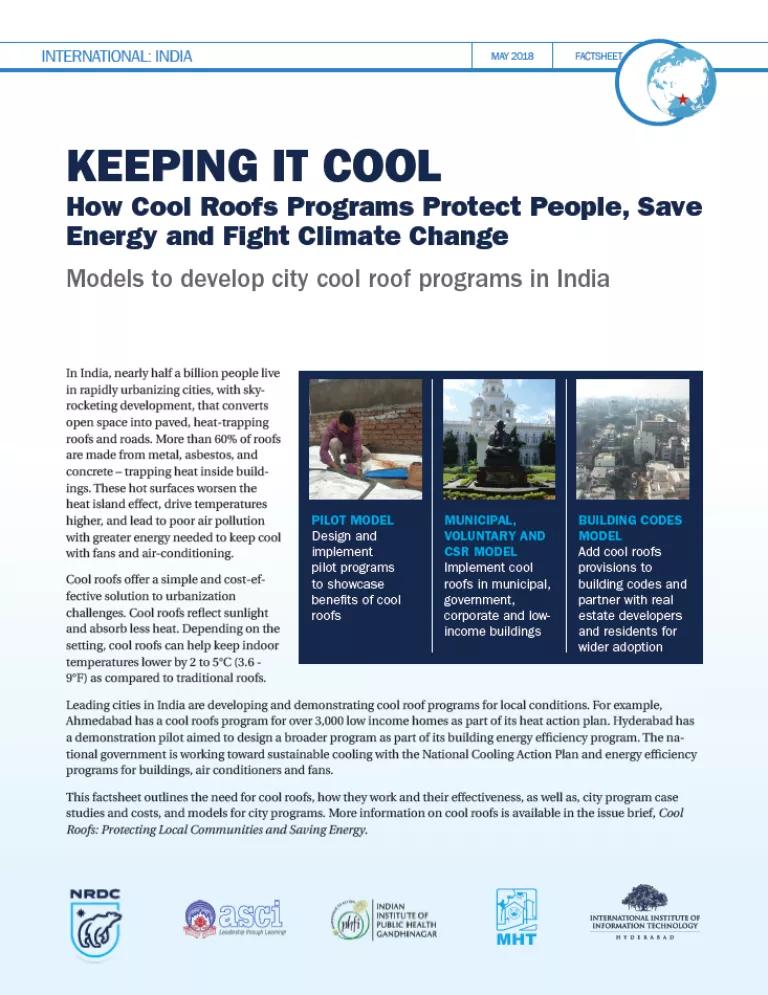
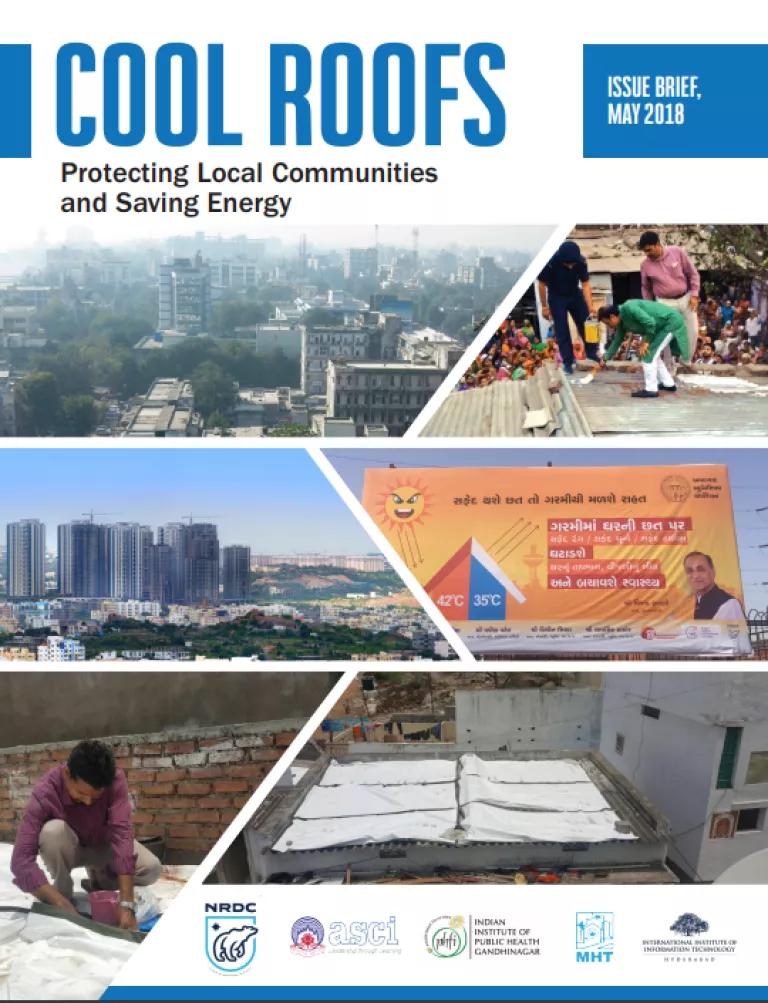
The factsheet and issue brief describe the innovative cool roof pilot projects deployed by the cities of Ahmedabad and Hyderabad in 2017 and 2018. Simple steps such as painting roofs with lime-based white wash, adding tarp-like coverings or white ceramic tiles—low cost, high-impact measures—can help bring roof surface temperatures down by as much as 30°C (86°F) and reduce indoor temperatures by 2 to 5°C (3.6 - 9°F). The issue brief also highlights examples from other cities in India as well as cities around the world. Here are links to the factsheet and issue brief.
Ahmedabad Cool Roofs Initiative
Since 2017, the Ahmedabad Municipal Corporation with partners NRDC, IIPH-G, MHT and others have included a cool roofs initiative as part of the Ahmedabad heat action plan for protecting communities from extreme heat. Ahmedabad’s initiative builds on extensive work by MHT who have installed over 100 cool roofs in low income communities in Ahmedabad, using a technology called ModRoof—roofs made of coconut husk and paper waste—as alternatives to traditional tin and asbestos roofs.
- Pilot Size: 3,000 roofs in 6 zones, expanding to include builder engagement
- Implementation: Ahmedabad city staff, along with 50 volunteer students from local colleges in Ahmedabad painted the roofs, expanding to corporate social responsibility programs
- Community Awareness: Pamphlets, hoardings and communication materials on cool roofs to increase community awareness on what cool roofs are, how they can help keep indoor temperatures lower and what materials can be used to convert to a cool roof
- Material and Cost: Locally-available white lime paint that costs ₹0.50 (~$0.07) per square foot for a total program cost of ₹700,000 ($10,450) for 2017, incorporated reflective paint coatings, and engaged 20-25 local real estate developers to expand cool roofs to private buildings in Ahmedabad on a voluntary basis in 2018
Hyderabad Cool Roofs Initiative
As part of the state building energy efficiency program, the Greater Hyderabad Municipal Corporation, partnered with ASCI, IIIT-H, and NRDC to implement a cool roofs pilot in low-income neighborhoods to showcase the benefits and impact of cool roofs in the city.
- Pilot Size: 25 city roofs in one low-income neighborhood
- Implementation: community member teams partnered with ASCI, IIIT-H, and NRDC to design, install and monitor results with inputs from Hyderabad officials
- Material and Cost: Dupont India supplied a high-density polyethylene (HDPE) cool roof coating membrane, Tyvek, for the pilot as a part of their corporate social responsibility efforts that actually retails in Hyderabad for ₹13/square foot ($0.2/square foot)
- Results: indoor air temperature lower by an average of 2°C (3.6°F) observed in the homes with cool roofs as compared to similar homes without cool roofs
- Resident Feedback Survey: 76% of the trial group residents expressed satisfaction with the cool roofs and others applied makeshift cool roof membranes to replicate cool roofs
Cool Roof Models
Cool roofs programs can have great benefits citywide, and should be tailored to a city’s needs and resources. Three emerging models exist: 1) pilot programs; 2) municipal, voluntary, and corporate social responsibility (CSR) programs; and 3) building code programs. These models for cool roof programs enable cities to steadily make progress while building community awareness and support. These three models allow city cool roofs program to grow from a single neighborhood to a city-wide effort. Identifying and mobilizing funding sources for each phase is critical to the program’s success.
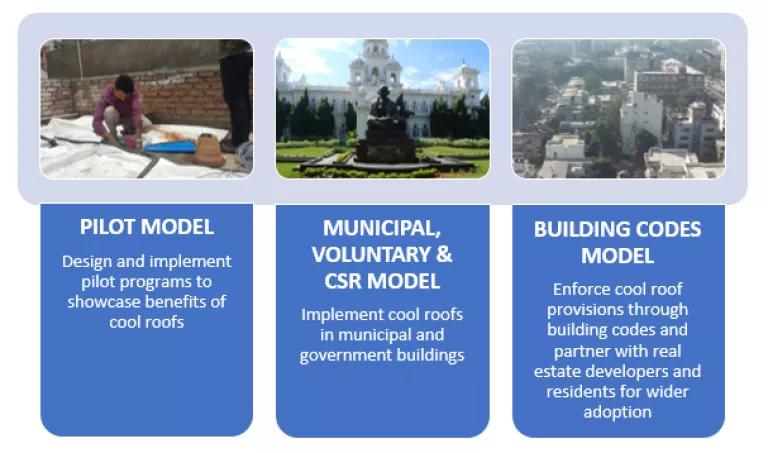
Update: For cool roof costs, the Telangana State draft cool roofs policy indicates the cost for lime wash is ₹1.5/square foot ($0.02) (plus labor). There are costs for other types of paints/coatings as well in the policy. Here is a link to the draft policy with cost information on page 14 (last page) - http://tsredco.telangana.gov.in/PDFs/Telangana_Cool_Roofs_Policy_for_Public_Comments.pdf


